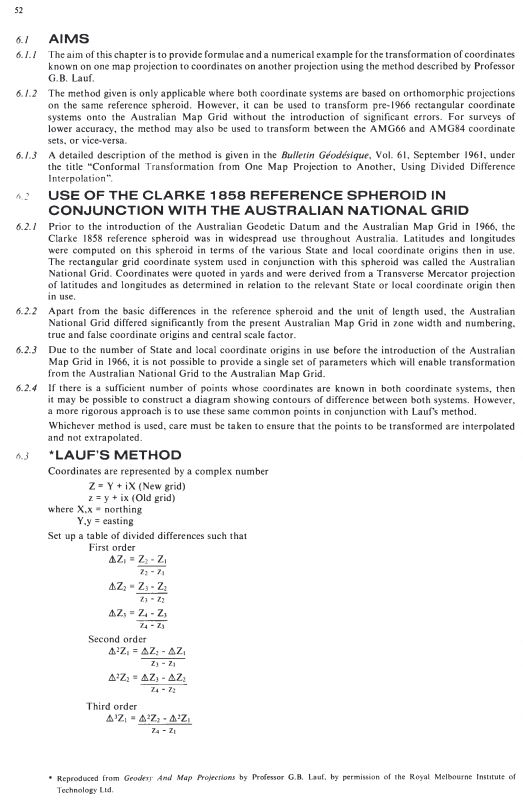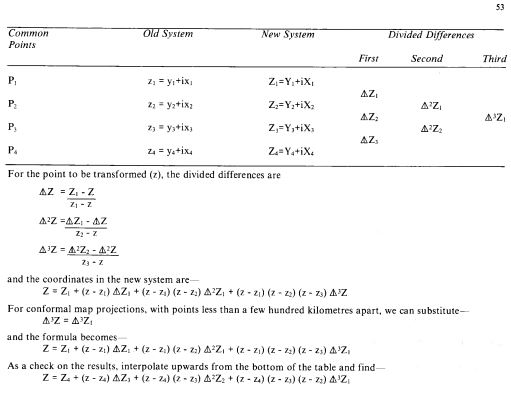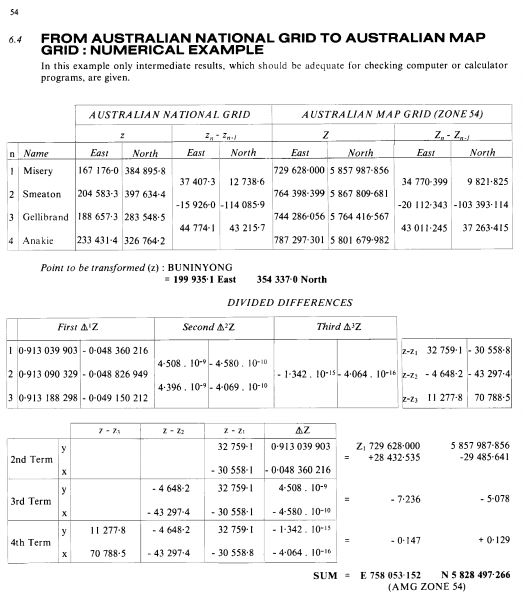Table of Contents
Georeferencing Historic Maps
Intro
This project aims to georeference historic maps which are of interest to bushwalkers in NSW, and make them available in a format which allows for easy viewing.
General parts involved are:
- Obtain digitised map through either
- Obtaining physical map and digitising using scanner or camera
- Downloading / acquiring a map that has been digitised by someone else (eg from the NLA via Trove)
- Georeference map
- By features
- Manually, by picking common points in both old map and one in the desired coordinate system
- Automated, through some algorithm that can identify common points and perform the process
- By coordinates
- Making use of the coordinates listed on the map (if available) and using a known coordinate transformation
- Display online
- Ideally would be a large tiled map for maps that are of a series, such as the LPI S1 topo
- A multi-layered version, where available maps are based on currently viewed bounds, see USGS Historic Topographic Map Explorer
Examples
Georeferencing by Coordinates
Here, twelve 1:63,360 scale military topographic maps were georeferenced and overlayed on the NSW LPI basemap. These digitised maps were sourced as low-quality JPGs (large TIFs also available) from the NLA (National Library of Australia) via Trove.
The maps were then georeferenced using the lat,long coordinates of corners of each map. These maps were generally published to cover 0.5 deg of long by 0.25 deg of lat, resulting in a regular grid of maps. Finally, they were clipped to cover only their mapped extent, removing the boards and information contained within.
No attempt was made to correct for the difference between the ANG and current GDA datums, so although the maps generally align with each other well, there can be discrepancies of 100s metres between the georeferenced maps and the LPI basemap.
Further work should be done in exploring variations of this process, particularly if a datum transformation can be applied.
Resources
Coordinate Transformation
When using old maps which have a CRS (coordinate reference system) significantly different from that which we use today, it can be useful to be able to transform coordinates from one CRS to another.
A brief overview of 'grids & datums' history for Australia can be found in this 2003 publication
Transformations listed before are quite well known, and many GIS packages can be used:
- AGD66 ↔ AGD84
- AGD66 ↔ GDA94
- GDA94 ↔ GDA2020
- GDA94 ↔ WGS84
Note that these refer to geographic datums, rather than map grids of a projection
| Geographic datum (short) | Map projection |
|---|
Some details for pre AGD66 transformations can be found in the AGD technical manual (pp 52-54) which have been included below for reference.
NTv2 Transformation Grids
Another way to transform coordinates is through a transformation grid. This is essentially a fancy version of a 'block shift' where the change (dLat and dLong or dE and dN) between the two CRSs was specified over a large region. An example of a rough block shift is adding 100m to eastings, and 200m to northings when transforming between AMG66 and MGA94.
A transformation grid uses the same principle but defines the shift at regular intervals throughout a region (eg, different values every minute). The NTv2 transformation grid is a specific file containing this information developed by Canada but now used throughout the world.
In many cases, you can find an NTv2 grid for the transformation you wish to perform. ICSM has produced multiple grids to transform between GDA94 and GDA202 which they have made freely available online. Grids for transforming between AGD66/84 and GDA94 also exist.
If a grid file does not exist for the transformation you wish to perform, it is possible (but appears difficult) to create your own. Some information about process flows was discussed in 2013 on the maptools mail list.
The Victorian land agency also appear to have a free tool perform transformations called GDAit
Killet Software has an NTvtTools package for developing and processing NTv2 files in both binary and ASCII formats. A trial version is freely available and a full licence currently costs 160 EUR.
A paper on the Generation of a NAD27-NAD83(CSRS) NTv2-type Grid Shift File for New Brunswick is also of interest.
An example - ANG to GDA94
The trial version of SEVENPAR by Killet Software was used to produce local parameters for a 7 parameter Helmann transformation. The trial version is limited to only 25 common points (locations known in both source and target CRS) so ones near Sydney sourced from the NGRS were used.
It's important to note the convention used (either Coordinate-Frame Rotation, or Position Vector) to define the three rotation parameters (signs are flipped between them).
The output in position vector format was:
| Parameter | Value | Units |
|---|---|---|
| dx | 195.056526 | m |
| dy | -112.959677 | m |
| dz | -172.456394 | m |
| rx | 3.59354054 | rad, seconds |
| ry | 5.39693644 | rad, seconds |
| rz | -1.34857381 | rad, seconds |
| s | -3.2756552 | ppm |
Combining these with the known values of the ellipsoid parameters of the ANS, a custom CRS can be defined in PROJ to allow transform between ANG and GDA94 coordinates. This can then be used in QGIS to 'reproject' ANG georeferenced rasters into a GDA94 CRS.
The following PROJ string was used to define the ANG CRS:
+proj=longlat +a=6378339.78 +rf=294.26 +towgs84=195.056526,-112.959677,-172.456394,3.59354054,5.39693644,-1.34857381,-3.2756552 +no_defs
This CRS is then available to be applied to any raster.
Coordinate Conversion
PROJ is a useful program here.
Note that PROJ is being updated and dramatically changed - a useful overview here.
Handy tables of parameters can be found here
Coordinate coversion for 1 inch to the mile millitary maps (ANG)
'Clarke Coordinates' or the 'ANG' (Australian National Grid) have the following parameters:
| Parameter | Value | Units |
|---|---|---|
| ellipsoid | Clarke 1858 | |
| a | 20,926,348 | british feet |
| a | 6,378,339.78 | metres |
| b | 20,855,233 | british feet |
| b | 6,356,663.92 | metres |
| 1/f | 294.26 | |
| projection | transverse mercator | |
| false easting | 400,000 | yards |
| false easting | 365,759.36 | metres |
| false northing | 800,000 | yards |
| false northing | 731,518.73 | metres |
| zones | 1 to 8 | |
| zone width | 5 | degrees |
| zone 1 central meridian | 116E | degrees |
| zone latitude origin | 34S | degrees |
| scale factor | 1 |
On these maps, Sydney Observatory was used as a datum for triangulation, with the following values:
| Format | Latitude | Longitude |
|---|---|---|
| DMS | S 33d 51m 41.10s | E 151d 12m 17.85s |
| DD | S 33.861417d | E 151.204958d |
The NGDB provides the following values of the observatory in different datums:
| Datum | Latitude | Longitude | Easting | Northing |
|---|---|---|---|---|
| Clarke | S33°51' 41.107“ | E151°12' 17.993” | 420746.19 | 816789.65 |
| AGD66 | S33°51' 40.2924“ | E151°12' 12.3136” | 333809.38 | 6251769.51 |
| AGD84 | S33°51' 40.3241“ | E151°12' 12.2557” | 333807.91 | 6251768.51 |
| GDA94 | S33°51' 34.610232“ | E151°12' 16.470597” | 333913.76 | 6251959.42 |
Note:
- The Clarke 1858 ellipsoid parameters used here are specified in british feet, with a conversion factor of 0.30479947 metres per british feet
- Differing values in metres are quoted online for the ellipsoid, however, this appears to be due to different conversion factors:
- Tasmania apparently used the Clarke foot which equalled 0.3047972654 meters
- Others appear to use today's standard conversion of 0.3048
- PROJ units:
- Input parameter values (eg, for ellipsoid or false origin)
- Appears that they can only be specified in metres
- If using other units, convert to metres before supplying parameter
- Output values (eg, eastings, northings, heights, lat, long)
- Allows you to specify your output units using +units-parameter, where the value is chosen from a set list (see
proj -lu, default is metres) - Alternatively, use the
+to_meter-parameterinstead and specify the value you multiple your unit by to get 1 metre (eg,+to_meter=100would output centimetres)
As an example, the below PROJ code will convert a lat,long (S 33.75, E 151.5) to E,N for zone 8 (cm=151e) of the ANG:
echo 151d30e 33d45s | proj +proj=tmerc +lat_0=34s +lon_0=151e +k_0=1 +a=6378339.78 +rf=294.26 +to_meter=0.91439841 +x_0=365759.36 +y_0=731518.73
Which returns: E=450,666.78 N=830,202.64
An explaination of parameters is as follows:
Parameters
+proj
- Description: Projection name
- Value: tmerc
- Value description:
- Projection used by ANG from June 1936
- Note: prior to 1936, a polyconic projection was used
+lat_0
- Description: Latitude of projection centre or true origin (TO) of projection.
- Value: 34s
- Value description:
- The true origin of ANG is 34 degrees south
- This is consistant across all 8 zones in Australia
+lon_0
- Description: Longitude of projection centre or true origin (TO) of projection. Also called central meridian (CM).
- Value: 151e (for zone 8 only)
- Value description:
- Each zone has a different CM. ANG has 8 zones covering the width of Australia
- Zone 8 covers the East of NSW
- Zones and their CM values can be found in the table below
- Each zone is 5 degrees wide in longitude, starting at 113d30e and ending at 153d30e
| Zone Number | Western Longitude | Eastern Longitude | Zone Central Meridian |
|---|---|---|---|
| 1 | 113d30e | 118d30e | 116de |
| 2 | 118d30e | 123d30e | 121de |
| 3 | 123d30e | 128d30e | 126de |
| 4 | 128d30e | 133d30e | 131de |
| 5 | 133d30e | 138d30e | 136de |
| 6 | 138d30e | 143d30e | 141de |
| 7 | 143d30e | 148d30e | 146de |
| 8 | 148d30e | 153d30e | 151de |
+k_0
- Description: Scale factor at the central meridian
- Value: 1 (default value for tmerc in PROJ)
- Value description:
- ANG has a scale factor (SF) of 1 at the central meridian
- This means that on the CM, a measured distance on earth will equal the corresponding grid distances
- East and west of the CM, a measured distance on earth will be less than the corresponding grid distances
+a
- Description: Semimajor radius of the ellipsoid axis
- Value: 6378339.78
- Value description:
- Based on Clarke 1858 ellposid with a defined as 20,926,348 british feet
- A conversion factor of 0.30479947 metres per british foot = 6,378,339.78m
+rf
- Description: Inverse flattening of the ellipsoid
- Value: 294.26
- Value description:
- Based on Clarke 1858 ellposid where the inverse flattening was defined as 294.26
+to_meter
- Description: Horizontal unit value for output coordinates
- Value: 0.91439841
- Value description:
- The ANG coordinates are in yards
- 1 yard = 3 british feet = 0.30479947 * 3 = 0.91439841 yards per metre
+x_0
- Description: False easting
- Value: 365759.36
- Value description:
- ANG has a false easting of 400,000 yards west of the true origin
- Converting into metres is 400,000 / 0.91439841 = 365,759.36 metres
+y_0
- Description: False northing
- Value: 731518.73
- Value description:
- ANG has a false northing of 800,000 yards south of the true origin
- Converting into metres is 800,000 / 0.91439841 = 731,518.73 metres



